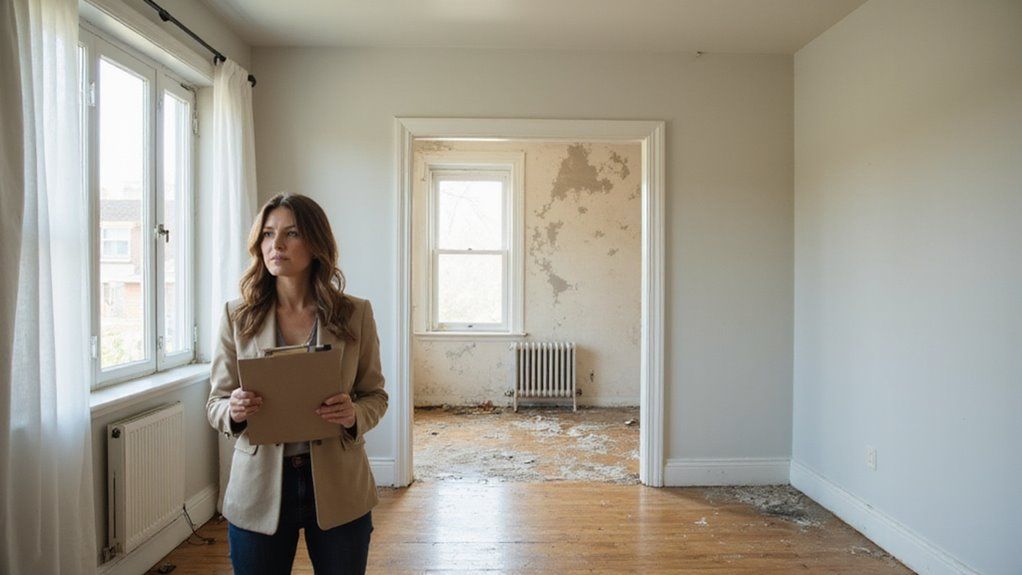How Selling a House With Mold or Water Damage Compares to Traditional Sales

Selling a house can be stressful, but mold or water damage makes it even harder. These problems scare away buyers and lower offers. Many homeowners feel stuck and unsure how to move forward.
Buyers worry about safety and repair costs, which slows down sales. Sellers must follow strict laws about disclosing damage. This leads to extra paperwork, delays, and sometimes legal trouble.
Selling a house with mold or water damage is much harder than a traditional sale because of extra risks and lower prices.
However, there are ways to handle these challenges and still sell your home. You just need to know the right steps to take.
This blog will explain those steps so you can sell your home more easily, even with damage.
Key Takeaways
- Homes with mold or water damage usually sell for less and take longer to sell than undamaged properties.
- Sellers must legally disclose known damage, while traditional sales face fewer disclosure risks and legal complications.
- Buyers often demand repairs, credits, or professional proof of remediation, resulting in tougher negotiations than with traditional homes.
- Damaged homes may face insurance and financing obstacles, unlike traditional properties which are more easily insurable and financed.
- Investor or cash buyers are more common with damaged homes, while traditional buyers dominate standard, undamaged sales.
Understanding Mold and Water Damage in Real Estate
Understanding Mold and Water Damage in Real Estate
Mold and water damage can lower a home's value and make it harder to sell. Buyers and lenders often worry when they see mold or signs of water problems.
If a home has these issues, it may be difficult to get full price or secure financing. Proper documentation, such as inspection reports and repair records, can help address these concerns. Recognizing the importance of property condition disclosures can also facilitate a smoother sale process.
Mold removal is not just for looks. It requires proper steps, like sealing off affected areas and removing all mold. If these steps are skipped, mold can return and create health risks. Proper remediation procedures ensure the problem is fully resolved and prevent future issues.
Water intrusion can come from leaky roofs, broken pipes, or cracks in the foundation. If left untreated, water can weaken the home's structure and help mold grow.
Fixing these problems early can protect your investment and improve your position during negotiations. Additionally, understanding required legal documents and how they relate to property condition can streamline the selling process.
Common Causes of Mold and Water Issues in Homes
Mold and water problems in homes often start with moisture getting inside. These issues can lower a home’s value and turn away buyers. If not fixed early, they may also affect the whole neighborhood.
Leaking roofs are a common cause. Damaged shingles or broken flashing let water seep into the house. This moisture can lead to mold growth and damage.
Leaking roofs allow moisture inside, creating the perfect conditions for mold growth and damage throughout your home.
Faulty plumbing is another source of trouble. Water from leaking pipes can hide behind walls or beneath floors. Such leaks create the perfect environment for mold.
Poor drainage also puts your home at risk. If gutters are clogged or the ground slopes toward the house, water can collect near the foundation. This can cause both mold and structural issues.
Inadequate ventilation increases humidity in places like basements and bathrooms. High moisture helps mold to grow quickly. Good airflow can help prevent this problem.
Addressing these causes promptly not only enhances your home's saleability but also helps maintain neighborhood property values.
How Disclosure Requirements Differ
Mold and water damage disclosure rules are different in every state and city. Some places require sellers to share detailed histories of mold or leaks. Other areas only ask for general information about serious defects.
If you do not follow local rules, you could face lawsuits or canceled sales. Certain states have strict penalties for failing to disclose problems. A few states use “buyer beware,” so the buyer must find issues during inspection.
You should always review your local laws and forms before selling. Real estate attorneys can help you understand your duties. Tailor your disclosure to your area’s specific rules to avoid mistakes.
Additionally, understanding disclosure requirements can help sellers navigate potential legal liabilities and ensure compliance with state laws. Being aware of flood and mold disclosure laws is essential, as they often vary significantly from one jurisdiction to another.
Impact on Property Value
Mold or water damage can lower a property's value. Buyers worry about future repair costs and health risks. Appraisers often mark down properties with visible or known damage.
Homes with these problems usually stay on the market longer. Buyers may give lower offers to cover repair expenses. Some people might not want to buy a home with past water or mold issues.
Appraisers reduce a home's value if they find damage or signs of mold. If the owner does not fix the problem, the price drops even more. Buyers also ask for price cuts if repairs are needed.
Insurance companies may refuse coverage for homes with mold or water issues. Some buyers will walk away if they cannot get insurance. This makes it harder to sell the property.
Liens and title issues can further complicate the sale process when dealing with distressed properties.
Buyer Perceptions and Concerns
You’ll find that buyers tend to prioritize health and safety concerns when mold or water damage is present, often perceiving heightened risks. These issues can trigger immediate doubts about property value and long-term investment security.
As a result, expect negotiation advantage to shift toward the buyer, who may seek significant concessions or price reductions. Additionally, selling a home quickly for cash can help mitigate these concerns by providing a swift resolution and avoiding prolonged exposure to the issues.
Health and Safety Fears
Mold and water damage create serious health and safety risks for buyers. These issues make buyers worry about breathing problems and unsafe living spaces. Many buyers want these problems fixed before they move forward with a purchase.
Mold releases spores that can cause asthma attacks and allergies, especially in children and sensitive people. If mold is present, families may look for a home elsewhere. Buyers may also request proof of professional mold removal.
Water damage can weaken walls and floors, making the home less safe. If the damage is not fixed, the house might not be insurable. Buyers may worry that repairs will cost more than expected.
If water or mold problems return after repairs, buyers may lose confidence in the property. Previous insurance claims for water damage can make buyers cautious. Buyers may avoid homes with a history of these problems to prevent future headaches.
Impact on Property Value
Mold and water damage can lower your property’s value. Buyers often reduce their offers to cover repair costs and possible risks. If your home has visible damage, it may sell for less than similar homes.
Buyers may question your home’s structure and systems if they see signs of damage. They could worry about air quality and long-term problems. Appraisers and inspectors usually note these issues in their reports.
These problems often lead to lower home values and stricter rules from lenders. Fewer buyers may be interested in your property. You may find it harder to sell quickly or for a high price.
Negotiation Leverage Shifts
When a home has mold or water damage, buyers usually gain more power in negotiations. This happens because buyers worry about repair costs and health issues. Sellers often get lower offers and must agree to strict conditions.
Buyers may use inspection results to ask for price cuts or repairs. If the market is slow, buyers become even more careful. Local laws might force sellers to reveal damage or fix problems before selling.
If buyers add strict inspection terms, closing can be delayed or the deal might fall through. Sellers should understand these changes to prepare better. Knowing this can help set realistic expectations during the sale.
Home Inspection Outcomes and Their Implications
A home inspection can reveal problems like mold, water damage, or structural issues. These findings are important because they affect the sale of your home. If issues are found, buyers and lenders may ask for repairs before moving forward.
Proper documentation and understanding of property condition are essential for a smooth transaction. Inspectors give detailed reports about the home's condition. Buyers use these reports to decide if they still want the house. If mold is confirmed, you must tell buyers and may need to hire professionals to fix it. Unresolved problems can lower your home's value and slow down the sale.
Addressing issues early can also help you avoid delays or legal trouble during the sale process. Lenders might refuse to finance homes with serious issues until repairs are complete. If you address problems early, you can make the sale process smoother and avoid legal trouble.
Negotiating Repairs and Credits
Negotiating repairs and credits starts after inspection reports show mold or water damage. Buyers use these findings to ask for repairs or credits. Sellers must decide whether to fix the issues or offer money to the buyer.
Sellers should get repair estimates from licensed contractors. Accurate estimates help support your decisions during negotiations. If you have clear costs, you can better explain your offer to the buyer. Market conditions affect negotiation.
Buyers may ask for more in a buyer’s market. Sellers may have more control in a seller’s market. If you offer repairs or credits, consider your bottom line. The goal is to keep the sale moving and protect your profit.
All agreements should be put in writing to avoid arguments later. Additionally, understanding fair, transparent transactions can help sellers navigate negotiations more confidently and ensure a smooth closing process.
Financing Challenges for Buyers
You’ll encounter significant financing hurdles when buyers face mold or water damage, including stricter mortgage approval criteria and potential insurance coverage denials.
Lenders often flag these properties as high-risk, making loan underwriting more complex and costly. Additionally, appraisers may assign lower property values, further complicating the transaction and limiting buyer options.
These obstacles can discourage conventional buyers, leading some sellers to consider alternative options such as cash sales process that bypass traditional financing challenges. Utilizing quick home cash sales can provide a faster, more certain resolution, helping sellers avoid prolonged delays or the risk of bankruptcy.
Mortgage Approval Obstacles
Lenders often reject or delay mortgages for homes with mold or water damage. They worry that these problems will lower the property’s value. If a home has these issues, buyers may face several challenges during approval.
Major lenders may not offer regular loans for homes with unresolved damage. Appraisers might value the home lower, which can affect loan amounts. Some lenders will also require repairs before they approve the loan.
If buyers only qualify for special loans, they may have to pay higher interest rates. The process can take longer if repairs are needed. Buyers should fix these problems early to avoid obstacles.
Insurance Coverage Issues
Getting homeowners insurance for a property with mold or water damage is often very difficult. Insurers check your claims history, and any past water or mold issues can lead to higher costs or denial. Most policies do not cover mold or old water damage, so future problems may not be protected.
If your property has these issues, it may be hard to get the insurance your lender needs. Lenders usually require full coverage before they agree to give a loan. Without proper insurance, you often cannot get regular financing, so the sale may fall through.
If you cannot secure insurance, the buying process will become much riskier. Sellers may need to fix the damage first or lower the price to attract buyers. If these steps are not taken, you may lose interested buyers to safer properties.
Appraisal Value Concerns
Homes with mold or water damage usually get lower appraisals. Appraisers consider visible problems and the cost of fixing them. These lower values can affect a buyer’s ability to get a loan.
Lenders often refuse loans if the appraisal notes unresolved mold or water damage. Appraisals also take into account negative market perception. This can make your home less attractive to buyers.
If the appraised value is low, buyers may ask for a lower price or back out of the deal. FHA, VA, and conventional loans may be harder to get for buyers. This situation can reduce the number of interested buyers.
Insurance Considerations and Obstacles
Listing a property with mold or water damage creates insurance problems. These issues make it hard for buyers to get coverage. Insurance companies often limit or deny policies for homes with existing damage. A thorough understanding of financial planning can help sellers navigate these challenges more effectively. If insurance is denied, buyers may feel worried or anxious.
Higher insurance costs can frustrate them. Long approval times cause uncertainty and may delay the sale. Lenders often refuse mortgages for properties with insurance exclusions. This may force sellers to fix the problems or offer credits. Sellers might earn less money as a result.
Additionally, a clear title is essential to reassure buyers and lenders that there are no underlying ownership issues that could complicate insurance or sale processes. Knowing these insurance challenges helps you prepare for negotiations. If you understand buyer concerns, you can set a better price and make deals smoother. Being ready for these obstacles can help prevent problems during closing.
Marketing a Damaged Home
When marketing a home with mold or water damage, you should highlight repair opportunities to attract value-focused buyers. It's essential to disclose the damage transparently to ensure legal compliance and build buyer trust.
Target investor buyers who specialize in distressed properties, as they're often equipped to assess remediation costs and recognize possible returns. Additionally, emphasizing the potential for rapid transactions can appeal to retirees seeking quick sales and financial certainty.
Highlighting Repair Opportunities
Highlighting repair opportunities lets you appeal to buyers who want to renovate for profit. If your property has water damage or mold, you can market it to investors and buyers interested in fixer-uppers. These buyers are often looking for homes they can improve and sell for a higher price.
You can show before-and-after renovation examples to help buyers see the home’s potential. Home staging can draw attention to strong features and make problems seem less serious. Honest details about repairs allow buyers to estimate costs and possible gains.
Comparable sales can help buyers understand the resale value after repairs. Flexible market timing can attract buyers who are ready to act fast. If you provide clear information, buyers can make decisions quickly.
Disclosing Damage Honestly
Full disclosure is required in real estate deals with mold or water damage. Sellers must tell buyers about any damage or repairs. This honesty is important for legal reasons and to avoid future problems.
Buyers need to know about water leaks, mold, or past repairs before making an offer. If you hide damage, buyers may sue later. Full disclosure helps set clear expectations and avoids surprises.
Sellers can use honesty to build trust with buyers. If you show which areas are fixed and which need work, buyers feel confident. Some buyers may even prefer a home with honest sellers, especially if they are ready to make repairs.
Being upfront protects your reputation. If you are clear from the start, deals are less likely to fall apart. Honest disclosure makes the selling process smoother for everyone involved.
Targeting Investor Buyers
To get the best price for a home with mold or water damage, focus on selling to investor buyers. Investors look for properties they can fix and resell for a profit. They judge a home by its repair costs and potential value after renovations.
If you want to attract investors, start by sharing clear repair estimates and the possible resale value. Show them recent sales prices for similar renovated homes. Make sure to provide inspection reports and all needed disclosures upfront.
If you can offer a clear title and flexible terms, investors may close the deal faster. Investors often value speed and transparency. This strategy helps you sell quickly, even in tough market conditions.
Legal Risks and Seller Liability
Selling a house with mold or water damage creates legal risks for the seller. Most states require sellers to tell buyers about known problems. If you do not share this information, you may face lawsuits or lose the sale.
Many states have strict rules that you must follow. If you break these rules, you could pay fines or face other penalties. Your reputation may also suffer if you do not follow the law.
You should always be honest about any damage. Getting a professional inspection can help you find all issues. Written records and early communication with buyers are the best ways to protect yourself.
If you are unsure about the laws, ask a lawyer for help. Legal advice can prevent future problems. Following these steps reduces your risk and helps you avoid serious consequences.
Timeline Differences Between Damaged and Traditional Sales
Properties with water or mold damage usually take longer to sell than traditional homes. Damage disclosure slows down the process and changes the usual sales timeline. If you want a fast sale, you may need to lower your price.
Damaged homes often need several inspections before buyers feel comfortable. Buyers might ask for repairs or a lower price, adding time to negotiations. If buyers are not satisfied, deals may fall through.
Lenders sometimes refuse loans for homes with damage or require repairs first. This can delay or even stop the sale. Sellers should expect extra steps if the home is not in good condition.
If you wait for the best market timing, damaged homes may not attract many buyers. Some sellers choose to accept quick, lower offers instead. Knowing these challenges helps set realistic plans.
Working With Investors Versus Traditional Buyers
Investors and traditional buyers respond differently to homes with mold or water damage. Investors look at numbers, while traditional buyers may worry about health and stigma. Sellers should know these differences to plan their approach.
Investors focus on property value, repair costs, and profit. They care less about emotional issues or a property's reputation. Their offers are usually cash and "as-is."
Traditional buyers often hesitate if a home has mold or water damage. They may be concerned about health risks and future problems. This can affect negotiations and the types of contingencies they request.
If you understand these differences, you can adjust your strategy for each buyer type. This can help you attract the right offers and avoid surprises. Knowing what matters to each group improves your results when selling.
Preparing for Closing With Mold or Water Damage
As you approach closing, you'll need to address mandatory disclosure requirements and maintain thorough documentation regarding mold or water damage.
Be prepared to negotiate repair concessions or credits, as buyers often utilize inspection findings to adjust terms. Appraisal challenges may also arise, impacting the property’s valuation and potentially complicating final approval.
Disclosure Requirements and Documentation
You must follow disclosure rules when selling a home with mold or water damage. These rules help protect you from legal trouble. Proper disclosure can also help buyers feel more confident.
State forms require you to list all known mold or water issues. You should fill these forms out truthfully. Past and present problems must be included.
If you fixed any mold problems, provide the paperwork. This may include invoices or reports from licensed workers. Buyers often want proof the problem was treated.
Show evidence of any water repairs. Receipts or contractor statements are helpful. These documents show you acted to solve the issue.
Inspection and testing reports must be shared if available. Lab results or environmental assessments show the current condition. Sharing these helps keep the sale process smooth.
Negotiating Repairs and Credits
Once you finish disclosures and gather documents, you must negotiate repairs or credits with buyers. Buyers may ask for repairs or closing credits to fix mold or water damage. If you want a quicker sale, you can offer credits or lower your price.
You should look at similar homes to set a fair price. Pricing your home lower shows honesty and attracts more buyers. If the damage is minor, buyers may accept a small credit.
You can share professional inspection reports or repair estimates with buyers. These documents help buyers understand the problem and trust your offer. If buyers feel informed, they may agree to your terms.
Sellers can fix the damage before closing or give a credit at closing. The choice depends on what the buyer prefers and local market trends. Being flexible helps keep the deal moving forward.
Inspection and Appraisal Challenges
Inspection and appraisal issues can delay your home sale when mold or water damage is present. Inspectors and appraisers will look for these problems. Their findings can lower your property’s value and affect how buyers see your home.
Inspection reports may point out mold or water issues, which can worry buyers. Appraisals might give your home a lower value if there is visible damage. Lenders may only approve loans if you fix these problems first.
You may need to provide proof of repairs to satisfy lender requirements. If you must disclose damage, your home might be seen as “distressed.” This can reduce your number of interested buyers and lower your sale price.
If you fix these issues early, you can make the closing process smoother. Being prepared helps you avoid last-minute delays. This approach increases your chances of a successful sale.
Conclusion
Selling a house with mold or water damage can be more challenging than a traditional sale. If owners do not disclose damages, they may face legal or financial problems. Buyers may offer less money, especially if repairs are needed.
If homeowners want a fast and easy sale, they can consider companies that buy houses for cash. We buy houses for cash, no matter the condition. This can help sellers avoid repairs, delays, and extra costs.
If you want to sell your house quickly and easily, contact Tulsa Home Buyers today. We can give you a fair cash offer for your home. Let us help you move forward without stress or hassle.
This is paragraph text. Click it or hit the Manage Text button to change the font, color, size, format, and more. To set up site-wide paragrapTulsa Home Buyers • August 24, 2025h and title styles, go to Site Theme.
Ready to work with Tulsa Home Buyers?
Let's connect! We’re here to help.
Send us a message and we’ll be in touch.
Or give us a call today at 111-222-3333


